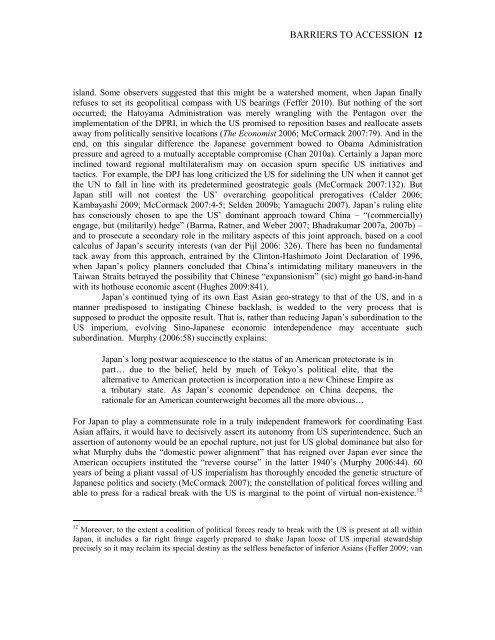Entire Volume 17 issue 1 - Journal of World-Systems Research ...
Entire Volume 17 issue 1 - Journal of World-Systems Research ...
Entire Volume 17 issue 1 - Journal of World-Systems Research ...
Create successful ePaper yourself
Turn your PDF publications into a flip-book with our unique Google optimized e-Paper software.
BARRIERS TO ACCESSION 12<br />
island. Some observers suggested that this might be a watershed moment, when Japan finally<br />
refuses to set its geopolitical compass with US bearings (Feffer 2010). But nothing <strong>of</strong> the sort<br />
occurred; the Hatoyama Administration was merely wrangling with the Pentagon over the<br />
implementation <strong>of</strong> the DPRI, in which the US promised to reposition bases and reallocate assets<br />
away from politically sensitive locations (The Economist 2006; McCormack 2007:79). And in the<br />
end, on this singular difference the Japanese government bowed to Obama Administration<br />
pressure and agreed to a mutually acceptable compromise (Chan 2010a). Certainly a Japan more<br />
inclined toward regional multilateralism may on occasion spurn specific US initiatives and<br />
tactics. For example, the DPJ has long criticized the US for sidelining the UN when it cannot get<br />
the UN to fall in line with its predetermined geostrategic goals (McCormack 2007:132). But<br />
Japan still will not contest the US’ overarching geopolitical prerogatives (Calder 2006;<br />
Kambayashi 2009; McCormack 2007:4-5; Selden 2009b; Yamaguchi 2007). Japan’s ruling elite<br />
has consciously chosen to ape the US’ dominant approach toward China – “(commercially)<br />
engage, but (militarily) hedge” (Barma, Ratner, and Weber 2007; Bhadrakumar 2007a, 2007b) –<br />
and to prosecute a secondary role in the military aspects <strong>of</strong> this joint approach, based on a cool<br />
calculus <strong>of</strong> Japan’s security interests (van der Pijl 2006: 326). There has been no fundamental<br />
tack away from this approach, entrained by the Clinton-Hashimoto Joint Declaration <strong>of</strong> 1996,<br />
when Japan’s policy planners concluded that China’s intimidating military maneuvers in the<br />
Taiwan Straits betrayed the possibility that Chinese “expansionism” (sic) might go hand-in-hand<br />
with its hothouse economic ascent (Hughes 2009:841).<br />
Japan’s continued tying <strong>of</strong> its own East Asian geo-strategy to that <strong>of</strong> the US, and in a<br />
manner predisposed to instigating Chinese backlash, is wedded to the very process that is<br />
supposed to product the opposite result. That is, rather than reducing Japan’s subordination to the<br />
US imperium, evolving Sino-Japanese economic interdependence may accentuate such<br />
subordination. Murphy (2006:58) succinctly explains:<br />
Japan’s long postwar acquiescence to the status <strong>of</strong> an American protectorate is in<br />
part… due to the belief, held by much <strong>of</strong> Tokyo’s political elite, that the<br />
alternative to American protection is incorporation into a new Chinese Empire as<br />
a tributary state. As Japan’s economic dependence on China deepens, the<br />
rationale for an American counterweight becomes all the more obvious…<br />
For Japan to play a commensurate role in a truly independent framework for coordinating East<br />
Asian affairs, it would have to decisively assert its autonomy from US superintendence. Such an<br />
assertion <strong>of</strong> autonomy would be an epochal rupture, not just for US global dominance but also for<br />
what Murphy dubs the “domestic power alignment” that has reigned over Japan ever since the<br />
American occupiers instituted the “reverse course” in the latter 1940’s (Murphy 2006:44). 60<br />
years <strong>of</strong> being a pliant vassal <strong>of</strong> US imperialism has thoroughly encoded the genetic structure <strong>of</strong><br />
Japanese politics and society (McCormack 2007); the constellation <strong>of</strong> political forces willing and<br />
able to press for a radical break with the US is marginal to the point <strong>of</strong> virtual non-existence. 12<br />
12 Moreover, to the extent a coalition <strong>of</strong> political forces ready to break with the US is present at all within<br />
Japan, it includes a far right fringe eagerly prepared to shake Japan loose <strong>of</strong> US imperial stewardship<br />
precisely so it may reclaim its special destiny as the selfless benefactor <strong>of</strong> inferior Asians (Feffer 2009; van





